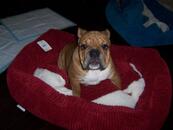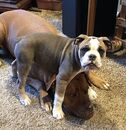Fbjdd
Active member
Hi all,
Well we just did a 4.5 hour ride to Penticton
 BC. The road is pretty winedy Bongo will stay standing pretty much the whole way good for about 1.5 hours but panting the whole way. Then his panting starts getting really dry and labored starts overheating. We stop give him a shot of lemon juice opens up his throat for awhile. Won't drink he's just really stressed. Any anxiety meds out there a vet told me children's gravol. Any suggestions would be awesome? He's buckled in the back seat usually with my wife and has lots of space.
BC. The road is pretty winedy Bongo will stay standing pretty much the whole way good for about 1.5 hours but panting the whole way. Then his panting starts getting really dry and labored starts overheating. We stop give him a shot of lemon juice opens up his throat for awhile. Won't drink he's just really stressed. Any anxiety meds out there a vet told me children's gravol. Any suggestions would be awesome? He's buckled in the back seat usually with my wife and has lots of space.
Well we just did a 4.5 hour ride to Penticton





